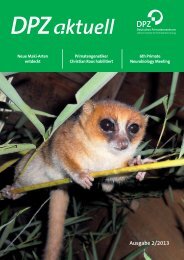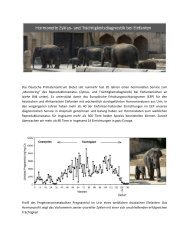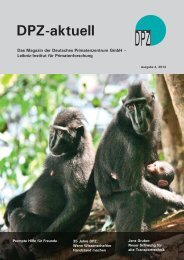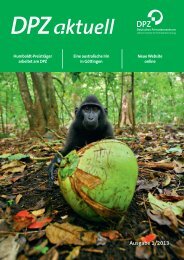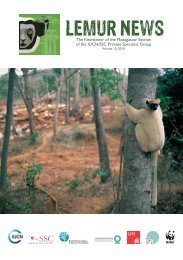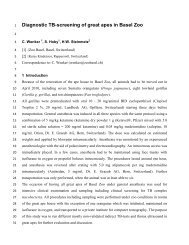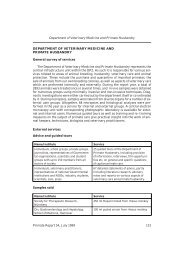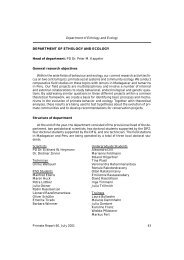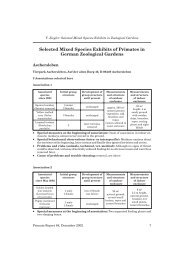DEPARTMENT OF ETHOLOGY AND ECOLOGY Head of ... - DPZ
DEPARTMENT OF ETHOLOGY AND ECOLOGY Head of ... - DPZ
DEPARTMENT OF ETHOLOGY AND ECOLOGY Head of ... - DPZ
You also want an ePaper? Increase the reach of your titles
YUMPU automatically turns print PDFs into web optimized ePapers that Google loves.
Farbpr<strong>of</strong>il: Generisches Offset-Separations-Pr<strong>of</strong>il<br />
Schwarz 150 lpi bei 45 Grad<br />
Progress during period under report<br />
Results<br />
In the past year, we made important progress on a number <strong>of</strong> fronts. In Madagascar,<br />
Oliver Schülke succeeded in capturing and radiocollaring fork-marked lemurs,<br />
so that it is now possible to initiate a field study <strong>of</strong> this intriguing lemur. Julia<br />
Ostner developed the necessary methodology for her study <strong>of</strong> the socio-endocrinology<br />
<strong>of</strong> redfronted lemurs. Barbara Wimmer developed the genetic tools necessary for the<br />
analyses <strong>of</strong> kin relations in several lemur species. Preliminary results <strong>of</strong> Rodin<br />
Rasoloarison's thesis work indicate the existence <strong>of</strong> at least four species <strong>of</strong> mouse lemurs<br />
that are new to science.<br />
Scent marking events / hour<br />
0,7<br />
0,6<br />
0,5<br />
0,4<br />
0,3<br />
0,2<br />
0,1<br />
0,0<br />
p < 0.01<br />
Department <strong>of</strong> Ethology and Ecology<br />
Male Female<br />
Different aspects <strong>of</strong> olfactory communication were addressed in coordinated comparative<br />
studies in tamarins and lemurs. Moustached tamarins (left graph) show a pronounced<br />
sexual dimorphism in favour <strong>of</strong> females with regard to scent marking (from:<br />
Heymann, E.W. (1998): Behav. Ecol. Sociobiol. 43:40). Latency <strong>of</strong> reaction <strong>of</strong> male<br />
and female recipients to three different types <strong>of</strong> scent marks in Lemur catta (right<br />
hand graph). Mean latencies (+SE) between deposition <strong>of</strong> female anogenital (Female<br />
AG), male anogenital (Male AG) and male antebrachial (Male AB) scent marks and<br />
first reaction with the same signal in male (black bars) and female (hatched bars) recipients<br />
are shown. The type <strong>of</strong> scent mark, but not sex <strong>of</strong> recipient, significantly influences<br />
mean latency. In a two-way ANOVA, the interaction (type x sex <strong>of</strong> recipient) was<br />
not significant (from: Kappeler, P.M. (1998): Behav. Ecol. Sociobiol. 42:411).<br />
Considerable progress was also made in the research carried out in Peru. Emerita<br />
Tirado succeeded in habituating red titi monkeys, Callicebus cupreus, so that a new<br />
comparative study <strong>of</strong> their behavioral ecology can now be initiated. The comparisons<br />
with the completed studies by Stefanie Heiduck on Brazilian masked titi monkeys,<br />
Callicebus personatus, and the ongoing studies on moustached and saddle-back<br />
tamarins (Saguinus mystax, Saguinus fuscicollis) provide an opportunity to elucidate<br />
the relative importance <strong>of</strong> ecological and phylogenetic factors in the evolution <strong>of</strong><br />
specific socio-ecological adaptations. Christoph Knogge and Emerita Tirado finished<br />
Primate Report 54, July 1999 53<br />
E:\jb98en\oekoenw.vp<br />
Dienstag, 7. September 1999 07:30:10<br />
Bild-Tafel: 3 von 13<br />
100<br />
95<br />
75<br />
25<br />
5<br />
0





